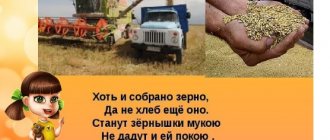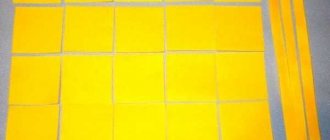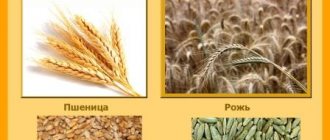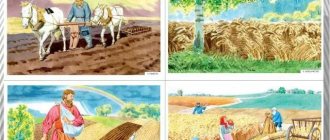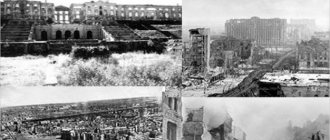Where did the bread on the table come from? GCD for cognitive development in the senior group
Summary of a lesson on cognitive development in the senior group
“Where did the bread on the table come from?” Author:
Melnikova Valentina Sergeevna, teacher, 1st qualification category
Target:
introduce children to how bread was grown in ancient times and in our time.
Tasks:
- Give children the idea that bread is a daily product.
- To instill in children respect for the work of adults (grain growers, bakers),
careful attitude towards bread.
- Develop logical thinking and attention.
Progress of the lesson:
The teacher asks: “Guys, what did you have for breakfast today?”
(Milk porridge, bun, tea)
And yesterday?
(Omelet, bread with butter, coffee)
What was for lunch?
(Borscht, vermicelli with cutlet, juice, bread)
Guys, the menu changes all the time, but what product is always on the table both morning and evening?
Children: “bread” Slide No. 1
That’s right, every day we have bread on the table both in kindergarten and at home.
Guys, do you like bread? What kind of bread do you like? (White, raisin rolls, soft).
Let's think about it and name a lot of words, what kind of bread is it?
(Tasty, soft, stale, white, hot, fresh, aromatic, appetizing) Slide No. 2
Bread can be different, but it is always tasty and healthy.
Guys, who knows where the bread came to us from? Children's answers (Mom bought it in the store)
How did he get into the store? Would you like me to tell you?
Well, then listen. First, I will introduce you to how bread was grown in Rus' before? Slide No. 3
First, the land had to be plowed.
So a peasant harnesses a plow or a horse to a plow and plows a strip of land. After this, it was necessary to sow the grain. Slide No. 4
We prepared for sowing in advance.
We washed ourselves in the bathhouse, put on a clean shirt and went out into the field with a basket on our chest. The basket contained wheat and rye seeds. Here is a sower walking across a field and every two steps he scatters a handful of grain in a fan, from left to right. Let's imagine that we are sowers. (Children show how to scatter grain.) What do
you think the weather should be like on this day?
(No wind.)
Why?
Children, what is necessary for the life and growth of plants? (Sun, rain in moderation.)
So people called rain.
“Rain, rain, water - There will be a loaf of bread, There will be rolls, there will be cakes, There will be delicious cheesecakes.” But the Russian people not only sang chants about bread, but also composed many proverbs about bread. Do you know proverbs about bread? (Children’s answers.) Slide No. 5
Educator.
Well done. Well, the wheat and rye have grown” and it’s time to harvest. In the old days they did it this way. The men took the scythes in their hands slide No. 6
, and the women took the sickles and went into the field.
Guys, pay attention to what a scythe looks like, and how slide No. 7
like a sickle, look at these tools and remember that they used them to harvest bread in Russia.
Slide No. 8
They cut the ears of corn and collected them into sheaves.
But the ears still had to be threshed, that is, the grains had to be removed from the ears, and to do this, people took slide No. 9
a flail - a hand-held threshing tool - and beat
slide No. 10 on the ears with it.
Then the grain was sifted and taken to the mill,
slide No. 11,
where it was ground, and flour,
slide No. 12, was obtained.
Look, I have flour in my plate.
Try it with your hands. What does it feel like? (soft, crumbly).
And from it, we know, they prepared a lot of tasty things, and most importantly, bread.
Slide No. 13
In Russia, bread was baked with domes, so that there was enough, like the sky, for everyone at the wide tables in the house.
It was considered a sin to abandon the baby. And bread and salt is a Russian custom, like a symbol of human kindness. Physical education lesson:
The wind is blowing from a height.
Herbs and flowers bend. Right-left, left-right. Flowers and grass are bowing. (Tilts to the sides).
Now let's get together.
Let's all jump in place (jump)
Higher, more fun, like that!
We all move to a step (walking in place)
So the game is over.
It's time for us to get busy. So we got to know how they used to grow bread in Rus'. Would you like me to tell you how bread is grown now in our time? Children: yes. Listen carefully! First people grow wheat and rye. Now, dozens of smart and powerful machines help people grow bread, slide No. 14.
In the fall, collective farmers begin to worry about next year's harvest.
They plow the ground deeply with a tractor slide No. 15
.
In winter, using snow plow slide No. 16,
more snow is stored in the field so that in the spring a lot of moisture accumulates in the soil.
Collective farmers also do not forget about food for future crops, slide No. 17
- they scatter manure, peat, and mineral fertilizers into the field.
In the spring, collective farmers use iron harrows, slide No. 18,
on a field that has been plowed in the fall, after which the field becomes soft, even, and retains moisture well.
Now you can start sowing! Collective farmers attach slide No. 19 seeders to the tractor,
and they place wheat grains in the soil in even, neat rows.
After that, they wait for the crop to grow. Finally, the wheat has ripened, slide No. 20,
and the collective farmers begin the harvest.
Combine harvesters with reapers slide No. 21
cut thick wheat and place it in windrows.
When the wheat in the windrows dries, it is picked up and threshed, slide No. 22.
To ensure that the grain is clean and selected, collective farmers pass it through a grain cleaning machine.
Slide No. 23
And then the grain is transported by truck to collective farm barns, elevators and mills
Slide No. 24.
From the mill, the ground grain is delivered to the bakery
Slide No. 25
From this flour at the bakery (the plant where bread is baked)
slide No. 26
they bake bread, rolls, loaves, saiki,
slide No. 27
bagels - everything that we love so much.
Ready-made bread, rolls, and loaves are delivered to shops by car. Slide No. 28
This is how bread gets to the store.
Slide No. 29 Playing with a ball (formation of related words to the word “bread”).
The teacher asks a question and throws the ball to the child, the child answers and returns the ball to the teacher: - Call the bread affectionately
(Khlebushek.)
What kind of bread crumbs?
(Bread)
What is kvass made from bread called?
(Bread.)
A device for cutting bread.
(Bread slicer.)
Utensils for bread.
(Breadbox.)
Who grows the bread?
(Bread grower.)
Who bakes the bread?
(Bread baker.)
Name the factory where bread is baked.
(Bread factory.)
What are the dough products called?
(Bakery products.)
Well done!
You played well. Guys, how many of you have seen how your mother makes dough at home? (Flour, water) Look at what components are needed Slide No. 30
Let's name them. (Children's answers).
When the dough is kneaded, it is placed in a mold and placed in the oven. When the bread is ready, it is loaded into cars and taken to the store. Guys, what else is baked from flour? Children's answers (rolls, loaves, pies, cakes). Didactic game “What is baked from flour?”
On the table there are pictures depicting different products: bakery products, dairy, meat, etc. Children are given the task of choosing only those pictures that depict products made from flour.
Children explain their choice. Well done! Well, guys, today we got to know how bread was grown in Rus' and how it is done now. Did you like it? What do you remember most? People have to put in a lot of work so that there is bread in every home, right guys? So how should we all feel about bread? ( Children's answers).
The teacher clarifies: What does carefully mean?
Where should I put the crumbs? Yes, guys, it is very difficult to grow bread and harvest it. Slide No. 31
Summary of a lesson in kindergarten “Where the bread came from.” Preparatory group
Notes GCD (cognitive development) “Where the bread came from” (Preparatory group)
Educator: Fedorova E.L.
Objectives: • generalize and systematize children’s knowledge about bread, the process of growing and making bread, enrich children’s vocabulary with adjectives • develop communication skills, develop logical thinking, memory, creative imagination • instill in children respect for the work of people who grow bread, cultivate a caring attitude towards bread , arouse interest in collective work. Preliminary work: Guessing riddles, explaining and memorizing sayings about bread, comparing spikelets of wheat, barley Material: TV, presentation about bread, a box of soil, a watering can with water, an electric and manual coffee grinder, all the ingredients for the dough, a “wonderful bag”, spikelets wheat and barley
Lesson progress:
1. Guys, we have guests today, let’s give them our smiles and greet them.
“Let’s hold hands together And smile at each other You are my friend and I am your friend All the friends around are friends” I’ll look at your faces, who should I make friends with here? I, Ekaterina Lvovna, and who are you? Tell me your affectionate name. 2. Guys, today we have an unusual activity, you will try yourself in several professions, but to find out what we are talking about, I suggest you guess the riddle “Soft, fluffy and fragrant, It is black, it is white, And sometimes it is burnt” (bread ) Today we invite you to find out where does bread come from? Get to know the hard work of the people who grow and bake it. And most importantly, you will also try yourself in some professions. 3. I have a “Wonderful bag”, you will find out what is in it by guessing the riddle: “It is golden and has a mustache, In a hundred pockets, a hundred children” (ear) (The teacher takes out ears of barley and wheat from the bag) Guys, you You guessed the riddle correctly, these are spikelets of various grain crops. (Look, touch them) Tell me what the ear of barley is called (barley) And what about the ear of wheat? (wheat) Now, look at these spikelets and tell me what they have in common, what are they made of? What does the proverb “Grain to grain will make a bag” mean? Plants that produce grain are called grain plants; the main food product of people, BREAD, is prepared from them. Guys, what kind of bread is there? Do you think it is easy to grow such spikelets? 4. Relaxation: “Spikelets” (to calm music) Imagine that we are in a field. I turn you into small grains and plant you in the ground (sit down). The warm sun warmed the earth, it began to rain, the grains grew, grew and became ears of corn (we slowly raise our hands up). The ears are reaching for the sun (feel the tension in your hands). Well, the sun is very hot, our ears of corn have wilted (relax, lower your head, arms, shoulders, lower yourself to the floor). But then the rain began to pour again, the spikelets came to life, and again reached for the sun. Wonderful spikelets grew in the field. Now smile at each other. 5. Now, look at the screen and you will find out how grain is planted and what comes out of it. Conversation: What should an agronomist know? (what grains, when to sow, when to harvest) What does a tractor driver do? (plows, harrows, sows grain) Experience No. 1: let's try to loosen the ground and plant grains. What is the job of a grain grower? (grows grain, takes care of it) What profession does a person remove grain from the field? (Combine operator) What machine does he use to do this? (combine) This important agricultural machine not only cuts the spikelets, it also knocks the grain out of them and cleans the grains with a stream of air. A combine is driving across a field and doing three things at once: reaping, threshing and winnowing. Experiment No. 2: let's try to separate the grain from the spikelet. Who transports the grain to the granary? (driver) What is another name for the place where grain is stored? (elevator) Where does the grain go from the elevator? (to a mill or flour mill) There the grain is turned into flour. Why do you need to grind grain? Experiment No. 3: Do you want to try grinding grains into flour yourself? Experiment No. 4: I will pour flour into one bag and grain into another. I'll mix it. Feel where the flour is? Where is the grain? How did you guess? What is flour for? (flour is used to make dough) Who prepares the dough and bakes the bread? Experience No. 5: we also invite you to be bakers, would you like to? Let's make the dough first. For this we need measuring cups, flour, eggs, milk, yeast, salt, sugar. We wash our hands and put on aprons. Well, let's get started. Look what kind of assistant we have. She will help us knead the dough. This is a bread maker. Do you know what this is? 6. And we will prepare a loaf from the dough. The basis for our loaf is ready. Let's decorate it? You see, guys, how much work it takes to get bread. The Russian people have always treated bread very carefully. Bread is the head of everything. Just three words, but that’s exactly what the proverb says about the importance of bread. What proverbs and sayings about bread do you know? While the children are working, we remember proverbs and sayings about bread: • Without bread, there is no lunch • Father’s bread is mother’s water • Bread will strengthen a person’s heart • If there is bread, there will be a song • Eat bread, salt, and listen to good people • Bread is bread’s brother • Bread - not a piece, longing in the throat • Bread in measure - money to count • Bread for dinner in moderation. Bread is a treasure, take care of it 7. Well, we’ve made our loaf beautiful, let’s take it to the kitchen and ask them to bake it, we’ll drink tea ourselves and treat our guests. 8. Summary of the lesson: questions about the lesson. Now you know how long our bread has traveled to get to our table. Bread is the main wealth of our country and it must be protected.
We recommend watching:
Summary of GCD on multitherapy for the preparatory group GCD in the preparatory group. Computer and its main devices Summary of GCD in computer science in the preparatory group of preschool educational institutions. Lots of activities for the preparatory group. My body
Similar articles:
Educational lesson in kindergarten dedicated to Cosmonautics Day
Cosmonautics Day in kindergarten. Scenario
Abstract of GCD in mathematics in the preparatory group. Counting to 11 and 12
Summary of mathematics lessons in the preparatory group. Number composition
Summary of mathematics lessons in the preparatory group. Adding and subtracting numbers
